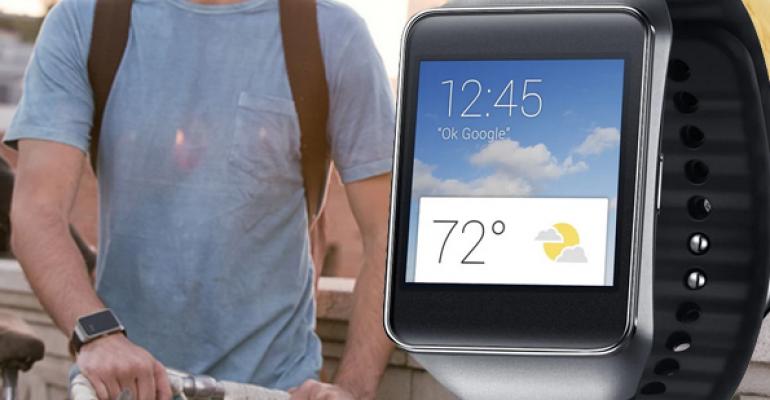With the wearable market suddenly taking off courtesy of Google's new Android Wear platform, I picked up a Samsung Gear Live watch to test alongside my Galaxy S5. It's an interesting peek at the future, and while I'll need some more time to really put it through its paces, a first look indicates that Google may be onto something.

As a means of reference, I also have a Samsung Gear Fit Watch which I've not written about yet. Frankly, I wasn't super-impressed with it, but it is now significantly less expensive than it was at launch (at least on Amazon), no doubt because of the more recent releases of two new Android Wear devices. (I also have—and use daily—a Fitbit Force, which I like quite a bit. So there are some interesting comparisons to be made here.)

Fitbit Force (left) and Samsung Gear Live (right)
My understanding of the Gear Live is that it is sort of the Android Wear version of the Galaxy Gear 2 Neo smart watch that Samsung started selling a few months back. That is, it is functionally similar in that it is an Android smart phone companion device. But instead of being limited to Samsung phones, you can use it with any recent Android (version 4.3+) phone, because the underlying platform is Android Wear and not Samsung's more proprietary system. Or something.
I wasn't super interested in Samsung's stuff—and even less so after I got that Gear Fit Watch—but Google's Android Wear entry is of course inherently interesting since they're the Android platform maker and will get this technology adopted across many device makers. Indeed, two are already available even at this early (some might say too early) date: the LG G Watch ($229) and the Samsung Gear Live ($199) that I picked up.
Is there a major difference between the two devices, aside from aesthetics and about $30? That's not entirely clear to me, but since my only goal was just to check out this platform, I went with the cheaper option.
The device itself is bulky, and brings back weird memories of the similarly-sized SPOT watches from 12 years ago, and I'm sort of surprised that hasn't improved measurably. That said, the screen is of course color, and not grayscale. And, while my wife would never wear such a large device—she couldn't even stand the relatively svelte Gear Fit—I don't find it objectionable. I do have large hands and wrists, however.

The worst part of the device is the charging system, which works like that for Gear Fit: It's USB-based, which is fine, but there's a stupid proprietary adapter piece you have to clumsily click in on the bottom side of the device. So not only do you need to take it off to charge it, but you have to really fight to get the charger on too. Given how big the watch is, it seems like there could have been a micro-USB port right on its side.

Getting started with Android Wear, the experience is much like it is with any other modern electronics device, where you spend a bunch of time downloading software updates even though the thing is brand new and then struggle to get it connected, in this case paired (via Bluetooth, presumably) to the phone. And you have to download and install the Android Wear app for the phone to make this all happen. After a bit of futzing about, and a lot downloading on the watch, you're up and running.

Android Wear devices function as watches by themselves and offer a number of built-in watch faces—most of them curiously terrible—but it's really not designed as a standalone thing. Instead, it integrates with apps and services on your phone. The interface is touch- and voice-based. You can swipe up on the face of the device to see different app notifications—Gmail, Facebook, Outlook.com, Weather, and an Android Wear-based fitness monitor in my case, and then swipe to the right on any of those screens to see more.
What you can do varies from app to app. When I see a new message in Outlook.com, for example, my only option is "Open on Phone." But with Gmail, I can choose between Archive, Reply and Open on Phone. And that Reply option lets you reply via voice. Weather shows you the current temperature and conditions, but if you swipe to the right you can see a three day forecast.

From a voice standpoint, the watch is of course a front-end to Google Now, which is probably pretty good. There are hints for things you can say like, "take a note," "remind me," "show me my steps," "show me my heart rate," "send a text to Jim," "email Jim," "agenda for today," and so on. I tried a few simple ones like "Call Stephanie on cell" and "show me the weather" and they worked as expected. Obviously this will be a major area for testing.
And of course it provides notifications for supported apps. So when an email comes in, the watch will vibrate, and you can look at it to see if it's something important. And if it is, you can deal with it, either on the watch or on the phone, depending on the app and your preferences.
The central question, of course, is whether a smart watch or other wearable will ever become a truly indispensable smart phone companion, or whether this is just technology for technology's sake. I'm leaning to the latter, but I won't prejudge. We'll see how it goes out in the real world.
More soon.





